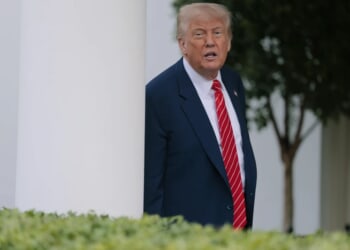Donald Trump plans to refill the Strategic Petroleum Reserve following historic drawdowns under Joe Biden, framing it as part of his energy dominance strategy.
President Donald Trump, during his inaugural address, pledged to refill the Strategic Petroleum Reserve (SPR) “right to the top” after historic drawdowns under the Biden administration. Designed to protect the U.S. economy from global energy shocks, the reserve is the world’s largest emergency crude oil supply. But it is currently at its lowest level in forty years, holding just under 400 million barrels.
What is the Strategic Petroleum Reserve?
President Gerald R. Ford established the Strategic Petroleum Reserve in 1975 as part of the Energy Policy and Conservation Act (EPCA), in response to the Organization of Petroleum Exporting Countries’ (OPEC) 1973 oil embargo, which left the United States vulnerable to foreign energy shocks. The goal was to create a vast oil reserve that would support national security and the American economy in the event of supply disruptions and geopolitical crises.
The U.S. government owns and operates the SPR, which can be used for emergencies, test sales, exchange agreements, and congressionally mandated non-emergency sales. Congress controls the approval for spending. However, the Secretary of Energy is responsible for purchasing oil to refill the reserve. The reserve itself is comprised of four sites along the Gulf Coast in Texas and Louisiana, where crude is pumped underground into large salt dome caverns that have low permeability and offer a geologically stable and secure method of storage. When full, the SPR has a storage capacity of about 714 million barrels.
Biden’s Historic Drawdown
In 2021, to pressure OPEC to increase production, President Biden released thirty-two million barrels in exchanges and eighteen million barrels in sales. Just a few months later, shortly after the Russian invasion of Ukraine, Biden ordered an emergency release of thirty million barrels, coordinated with the International Energy Agency (IEA), and then ordered the largest release in SPR history—180 million barrels over the course of six months—in order to ease gasoline prices and inflation. Altogether, he sold off nearly 300 barrels during his term. While the drawdown helped to reduce gas prices by seventeen to forty-two cents a barrel, it also cut the reserve nearly in half.
The Biden administration later initiated purchases to begin refilling the reserve, acquiring about sixty million barrels. However, the Department of Energy (DOE) eventually ran out of funds and was unable to continue buying more oil. Any further refill would have required new appropriations from Congress. By the end of Biden’s term, the SPR stood at 394 million barrels, down from around 638 million barrels when he took office in 2020.
Trump’s Pledge to Refill the Reserve
Trump has largely defined his energy policy around the idea of “energy dominance,” and the SPR, originally designed to protect the United States and reduce reliance on foreign oil, fits into that strategy. With SPR levels at their lowest in over four decades, his administration has committed to rebuilding the reserve not just as an emergency asset, but as a cornerstone of U.S. energy policy.
According to Secretary of Energy Chris Wright, it would take about $20 billion and five to six years to refill the reserve completely. In March, Wright announced his plan to seek that $20 billion from Congress, but this petition will not happen all at once. Instead, the administration plans to phase in the request and work with Congress to cancel the required sale of one hundred million barrels from the reserve between now and 2031. House Republicans have already taken a first step, including $1.3 billion for SPR refilling and another $218 million for maintenance and repairs in their budget proposal. The bill also eliminates the mandatory sale provision.
Geopolitical Context
Trump’s plan to refill the Strategic Petroleum Reserve is unfolding against the backdrop of a changing global oil market—and an inflection point for U.S. shale. Despite Trump’s promises to champion American drillers, domestic production is showing signs of plateauing. Companies that once fueled the U.S. shale boom are pulling back as commodity prices fall and well inventory shrinks. “We believe we are at a tipping point for U.S. oil production at current commodity prices,” Diamondback Energy CEO Travis Stice told shareholders, reflecting broader industry sentiment that the boom years may be behind them.
While overall U.S. production is expected to rise modestly in 2025—largely due to offshore projects—it’s projected to decline by one percent the following year to thirteen million barrels per day, marking the first non-pandemic year-on-year drop in over a decade. The slowdown is most visible in the Permian Basin, where production growth has sharply decelerated. Additionally, while the Bakken and Eagle Ford shale regions were once central to the U.S. oil renaissance, they have not fully recovered since the pandemic. In the meantime, producers are hesitant to set up rigs in a weak price environment because inflation-adjusted oil prices are still far below the $85-per-barrel threshold required to encourage drilling.
Amid this domestic cooling, Trump is looking abroad. One emerging possibility is that OPEC nations such as Saudi Arabia and the United Arab Emirates could increase production, something they have already been looking to do, and that surplus could be funneled into the depleted SPR rather than released into the global market. Mukesh Sahdev of Rystad Energy noted that this approach would allow Gulf producers to achieve that increased output without lowering prices, as Brent hovers around $65 per barrel, well below the $80 a barrel Saudi Arabia needs to balance its budget. The arrangement also supports Trump’s foreign policy playbook. By filling the reserve with Middle Eastern crude, the administration will bolster ties with key Gulf partners and gain leverage over sanctioned producers such as Iran, Venezuela, and Russia.
The Reserve’s Role Is Evolving
The idea of refilling the Strategic Petroleum Reserve is not new, as it was always intended to be full to serve its purpose. However, Trump’s larger energy dominance strategy will be complicated by his push to double down on fossil fuels, given that global supply is increasing and U.S. shale production is plateauing. What remains to be seen is if the reserve can be used to maintain and strengthen American clout overseas and stabilize markets at home.
About the Author: Emily Day
Emily Day is an experienced researcher, writer, and editor with expertise in geopolitics, nuclear energy, and global security. She is an Associate Editor of Energy World at the National Interest, a Della Ratta Energy and Global Security Fellow at the Partnership for Global Security, and a Research Associate at Longview Global Advisors, where she provides insights on global political and economic trends with a specialization in utilities, risk, sustainability, and technology.
Image: Teun van den Dries/Shutterstock

















